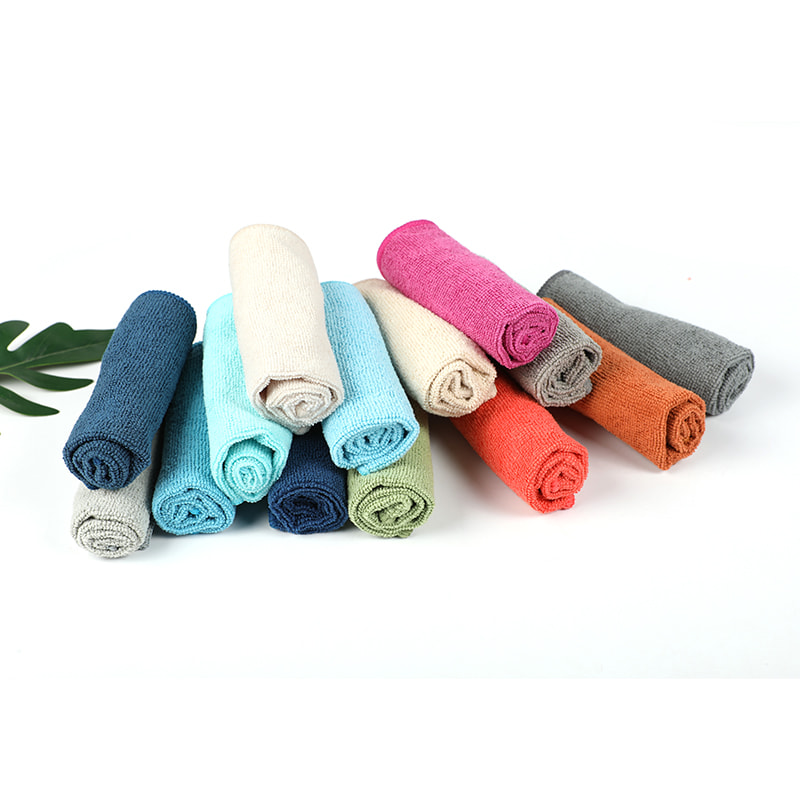We are a national high-tech enterprise. At present, there are many kinds of self-woven and cooperatively processed fabrics, including microfiber warp-knitted towel cloth, weft-knitted towel cloth, coral fleece, etc.
Properly sanitizing kitchen cleaning towels is crucial to prevent bacterial growth and maintain hygiene in the kitchen. Here's a step-by-step guide:
Pre-Treatment: Prior to laundering, initiate the cleaning process by pre-treating the kitchen cleaning towels. Begin by filling a basin or sink with hot water, ideally as hot as the fabric can withstand without damage. This temperature variation is typically indicated on the care label. Add a generous amount of a suitable detergent known for its grease-cutting abilities, ensuring it's compatible with the fabric. Allow the towels to soak for a sufficient duration, usually around 15-30 minutes. This soaking period facilitates the breakdown of tough stains, grease, and food residues, loosening them from the fibers and preparing the towels for thorough washing.
Wash with Hot Water: When it's time to launder the towels, select the hottest water temperature setting recommended for the specific fabric type. Hot water is highly effective in killing bacteria, viruses, and other pathogens, making it an essential component of the sanitization process. The elevated temperature not only aids in eliminating microbial contaminants but also enhances the detergent's cleaning power by improving its solubility and dispersion. This ensures that the detergent can penetrate deep into the fabric to lift and suspend soils for easy removal during the wash cycle.
Use a Disinfectant: Enhance the sanitization process by incorporating a disinfectant into the wash cycle. Options for effective disinfection include chlorine bleach, hydrogen peroxide-based cleaners, or commercially available disinfectant products approved by the Environmental Protection Agency (EPA). It's imperative to carefully follow the manufacturer's instructions regarding the proper dilution ratios and usage guidelines to achieve optimal results without compromising the fabric's integrity. The disinfectant works synergistically with the hot water and detergent, targeting and eradicating any lingering microbial contaminants to leave the towels hygienically clean and safe for use.
Avoid Overloading: To ensure thorough cleaning and maximum sanitization efficacy, avoid overloading the washing machine with too many towels. Overcrowding impedes the free movement of the towels during the wash cycle, preventing adequate agitation and water circulation. This can result in insufficient detergent distribution and inadequate soil removal, compromising the overall cleanliness of the towels. Instead, load the washing machine with a manageable quantity of towels, allowing ample space for them to move and agitate freely. This facilitates optimal cleaning performance and ensures that each towel receives equal exposure to the detergent and disinfectant for consistent sanitization results.
Choose a Proper Detergent: Selecting the appropriate detergent is paramount to achieving effective cleaning and sanitization of kitchen cleaning towels. Opt for a high-quality detergent specifically formulated for use in hot water and designed to tackle tough grease, oils, and food residues commonly encountered in kitchen environments. Look for detergents containing powerful surfactants and enzymes capable of breaking down and emulsifying soils to facilitate their removal during the wash cycle. Additionally, consider factors such as fragrance-free or hypoallergenic formulations if sensitivities or preferences dictate, ensuring a pleasant and comfortable user experience without compromising cleaning performance.
Dry Completely: After laundering, it's essential to thoroughly dry the kitchen cleaning towels to prevent bacterial regrowth and maintain their cleanliness. Utilize a hot dryer setting to subject the towels to elevated temperatures that further sanitize and disinfect the fabric, effectively killing any remaining bacteria or pathogens. Alternatively, if outdoor space permits, hang the towels in direct sunlight, harnessing the natural sanitizing properties of UV radiation. Ensure that the towels are completely dry before storing them to prevent the development of mold, mildew, or unpleasant odors, which can compromise their hygiene and usability.
520GSM single-sided coral fleece car towel/car interior cleaning/kitchen cleaning

520GSM single-sided coral fleece car towel/car interior cleaning/kitchen cleaning


 English
English Espaol
Espaol русский
русский عربي
عربي 简体中文
简体中文
















